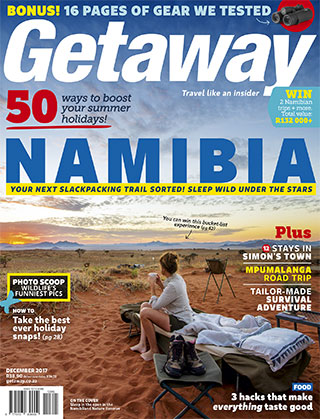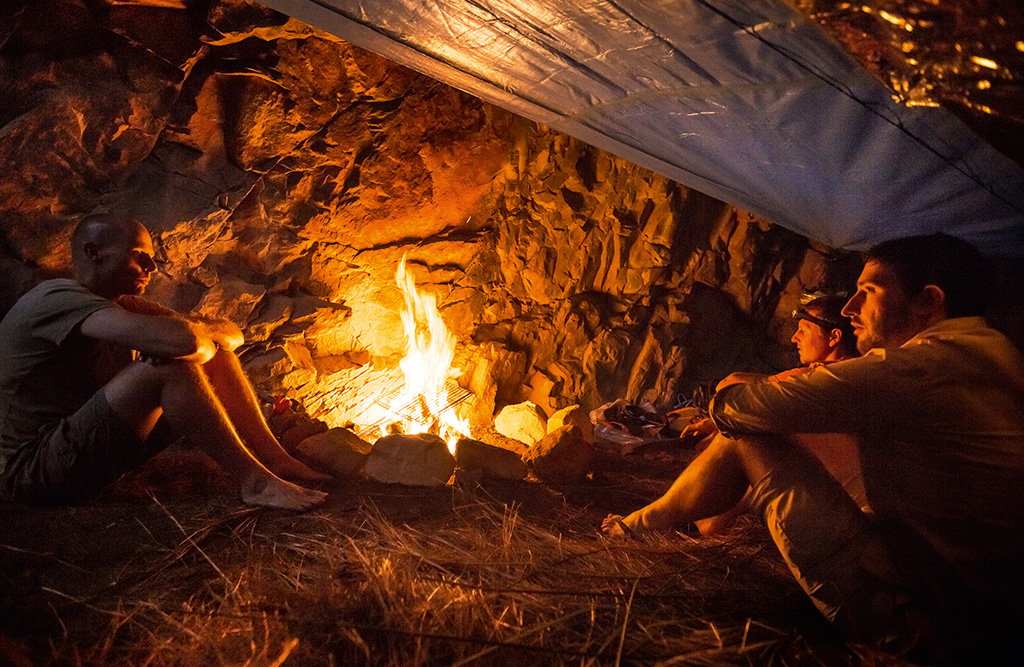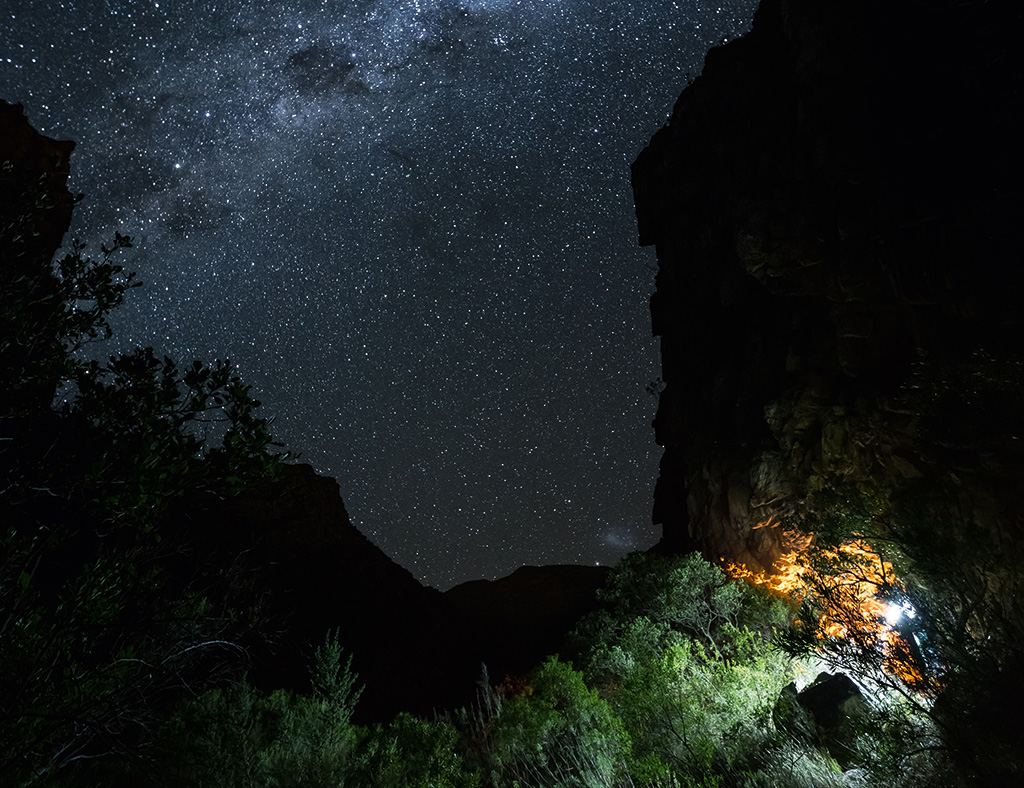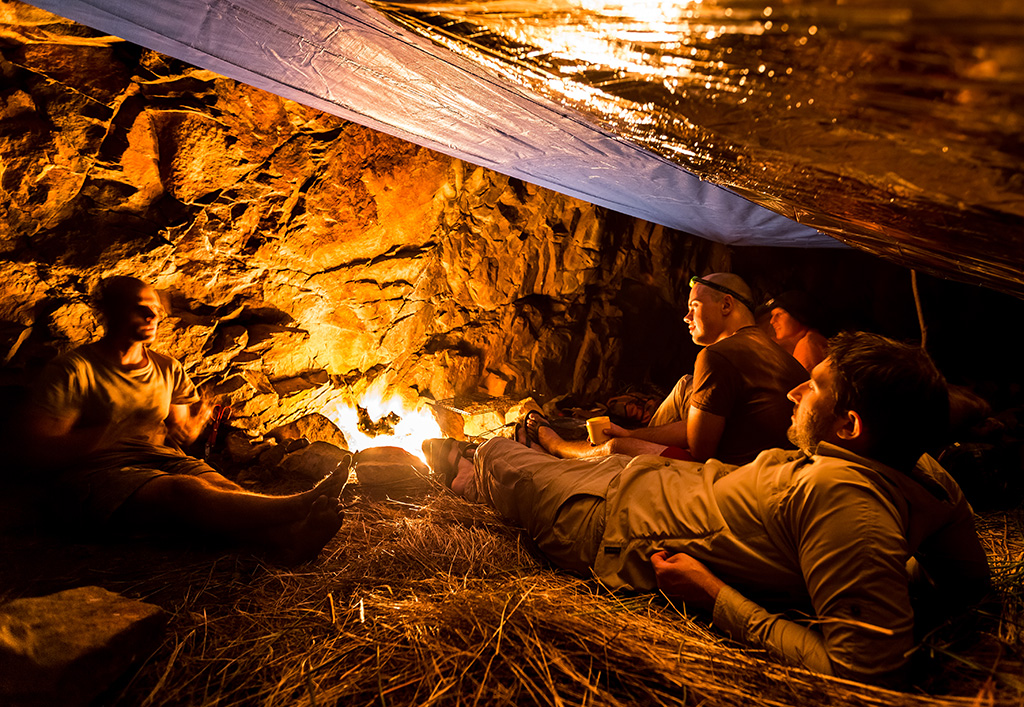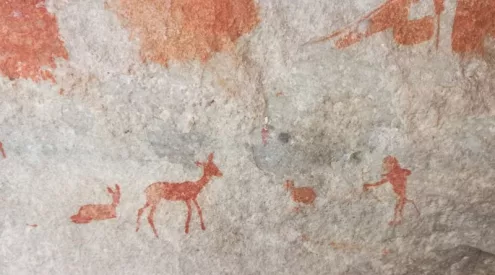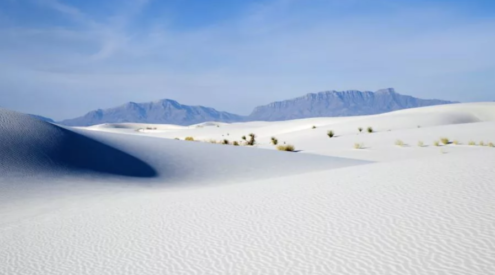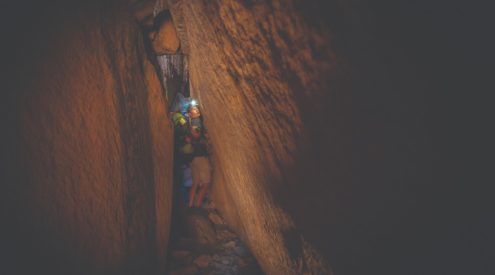This customisable wilderness experience in McGregor could save your life one day, but it’s the learning that’s the biggest delight anyway.
Also read: Don’t die while hiking: survival tips from a pro
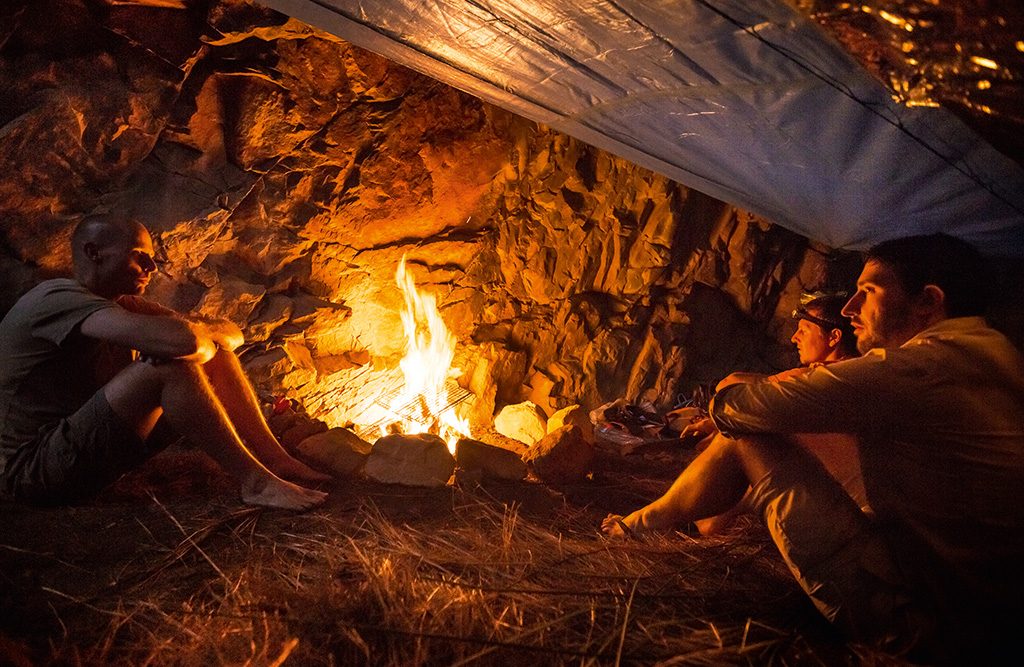
Think caves are unpleasant places to spend a night? They are, unless you know a few tricks. You’ll learn the skills to create cosy caverns like this – important if you’re caught in the cold. Photo by Chris Davies.
When I was nine years old, my zoologist father secured a six-month secondment to research the then drought-stricken rivers of Kruger National Park. Looking back, I have only the vaguest memories of our drive from the Cape – a jam-packed VW Kombi, a stop in Grahamstown, a storm – but my first real memory is vivid: the frost-hard rugby field of Laërskool Skukuza, a madhouse of skinny, bronzed rangers’ kids who could ping a tennis ball off your head at 20 metres.
Stingers was the game of choice that bright, crisp winter; we charged barefoot across the turf, pelting the hell out of each other, then walked home past hippos and giraffes to set scorpion traps or maybe chase some impala.
For weeks at a time my family and I would join my dad, wild camping on some desiccated confluence. After a hateful morning’s maths tables, I’d be free to hunt bugs, build fires or shadow the adults, eavesdropping on their stories. I learnt a lot in those six months, scrabbling in the dirt and scabbing my knees. Animal spoor soon became easy to identify; edible and useful plants, too. There was so much to learn and I soaked it all in, especially all the many types of pooh. Rhyming things with pooh was pretty funny back then.
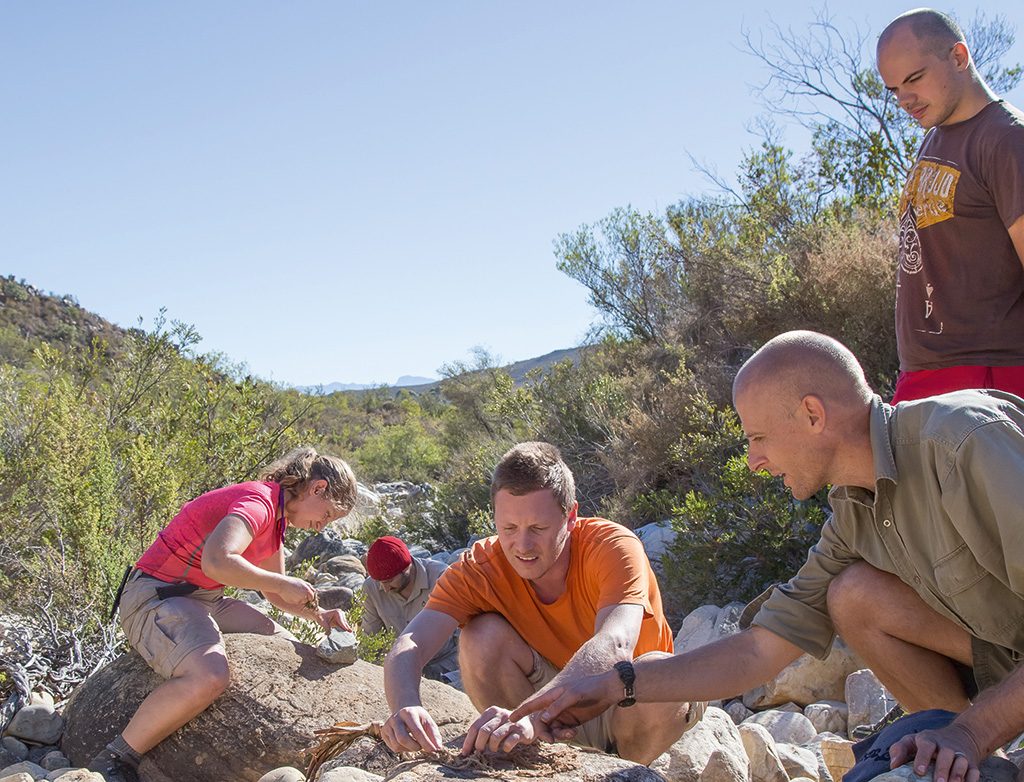
Being able to make a fire is key to any survival situation – this crushed, oily tree bark made for excellent kindling. Photo by Chris Davies.
As endless as they seemed, however, those six months soon passed, and you don’t hold onto detailed faecal knowledge back in the city. In fact, you probably shouldn’t. Still, I did retain a lasting love for the bush and a fascination for its many secrets. I return as often as I can but I’ve never quite regained that youthful proficiency.
Nearly three decades on, I get a surprise birthday present from someone who clearly knows me well: a day-long ‘introduction to survival’ course on a smallholding near Nelspruit. Course leader Hunt Cheney strides out as I arrive, barefoot in his khaki kortbroek and light-green T-shirt. Giddy as a kid I throw myself into rope weaving and atlatl throwing (a tool for hurling spears) and we chat: aside from nominative determinism, how do you get involved in survival training anyway?
Hunt, it turns out, is just a year or two my senior and grew up in Kruger, attending Laërskool Skukuza at about the same time I was dodging tennis balls – a few perhaps even hurled from his arm. The son of Cleve Cheney, a Kruger ranger for 28 years and author of volumes on conservation, hunting and tracking, Hunt began accompanying his father into the veld from the age of five. By eight he was spending nights out on his own, building shelters and foraging for food a short hike from their home. At 16, he spent two full months alone in the Kruger bush, surviving and thriving with nothing but his shorts and an old T-shirt.
After working as a medic and outdoor instructor near Nelspruit, Hunt has now moved to the Cape and spends his time training anti-poaching units in tracking and teaching beginner- to advanced-level survival courses all over South Africa. The latter simulate real survival situations and must be completed incrementally. His introductory courses are far less severe – think entirely customisable wilderness experiences with your own private expert and a couple of cold beers around the braai each night. Good morale is, after all, the key to every survival situation.
A few months go by and, unsatisfied by my single day’s adventure, I convince a group of family and friends to join me, and Hunt, on a two-night introductory course on a farm outside McGregor. After a short Q&A on what we’d most like to cover, we set off to our home for the weekend: a shallow cave in a narrow kloof, icy mountain water gurgling through nearby reeds.
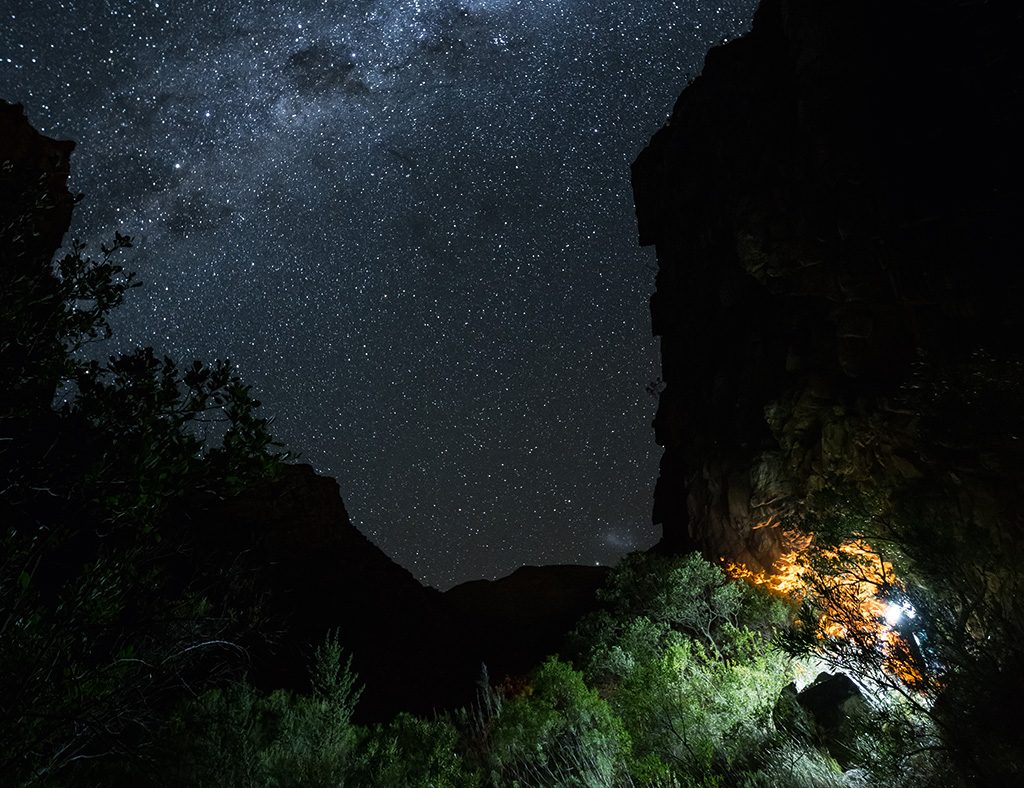
This shallow cave in a kloof outside McGregor was our comfortable home for the weekend. Photo by Chris Davies.
Soon we’re cutting grass for our bedroll, learning knots and placing choke stones into cracks in the cave wall. A good night’s sleep is as good as a meal, Hunt declares, and by the time we’re done, our shelter is as snug as any tent I’ve ever had. All the while, Hunt, almost shyly, instructs. Did we see that tree with the leopard claw marks? What about the porcupine track on the path over there? We make char cloth and fire with flint and steel and fashion spring-loaded fishing traps from branches and twine. As our questions flow, the answers flow back, and around the fire that night, Hunt’s bush stories keep coming.
‘Yeah, I kind of had a pet lion once, while it was being rehabilitated … he used to play-hunt me in the section ranger’s garden. Would beat me to the stoep even with my 50-metre head start; ankle tap me before I could reach the stairs.’
The flames cast dancing shadows across the cave wall as we sit rapt, one incredible story chasing the other. We sip our beers, eat our boerie and listen late into the night.
In the early hours, I tiptoe out of the cave to rid my body of some beer. Katabatic mist rolls down the kloof and I take a moment to appreciate I’d just relearnt the word, then toss another log onto the dimly glowing fire. As a nine-year-old, I got first-degree burns across my right hand while baking mud balls on a fire to chuck at crocodiles in the Limpopo River. I’ve never forgotten that, and as I fall back to sleep I can’t help wishing I’d retained more interesting lessons other than ‘don’t pick up balls of kiln-hot mud’.
On day two we’re up early, feeling refreshed. Considering the rocky discomfort our little cave first presented, nobody can quite believe we’ve had such a good night’s rest. There’s no rush as we stoke the fire and cook oats for breakfast. Hunt’s introductory courses are completely flexible and it’s up to each group to decide what they’d like to cover. Tracking had come up the night before, so after coffee we gather around and listen attentively as Hunt goes over the basics. These are not skills you can learn in a morning, but they’re fascinating nonetheless. If ever you’re searching for a lost child, know that kids tend to head up to higher ground, as opposed to adults, who most often follow downward routes into gullies and gorges.
Next comes an inventory of the survival kit Hunt keeps handy at all times. I look around at the group and realise I’d been a bit nervous about how they’d take to all of this. But watching them now is a relief – my sister has grabbed Hunt’s homemade throwing sling and we all line up to be shown how to use it. Soon rocks are pinging off the canyon walls, which echo with shouts and laughter.
Tomorrow we’ll be back in the city, and fish traps and slings and shelters will soon be forgotten. But maybe not completely – and maybe one day they’ll even be of use. But whether practical or not, retained or forgotten, learning them again will always be a pleasure.
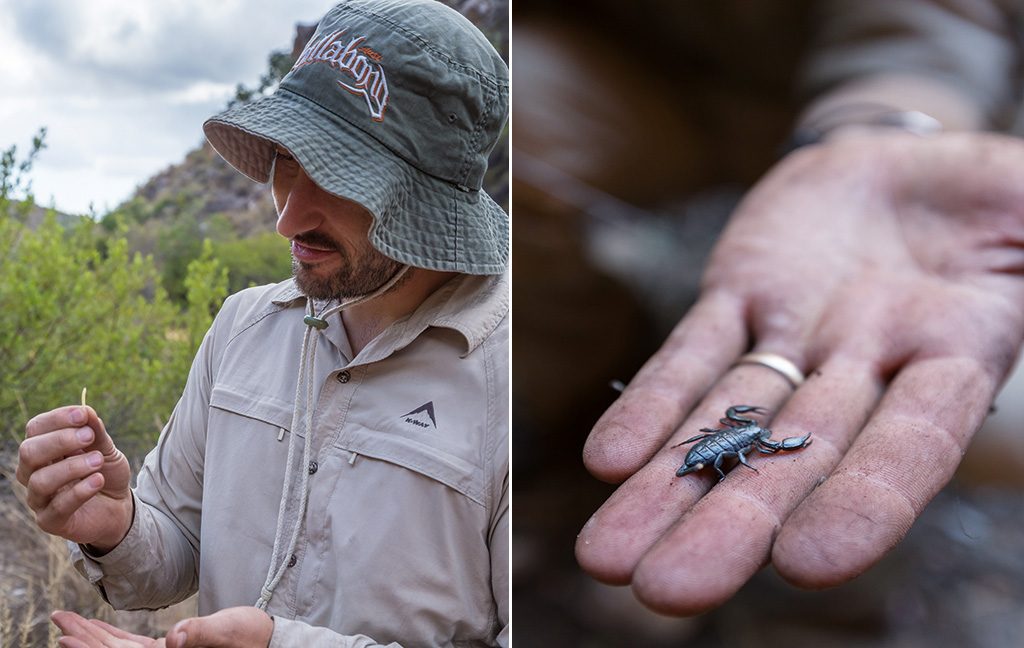
Eating grubs is definitely not compulsory, but you’re welcome to give them a try if that’s your thing; As a general rule, scorpions with big pincers and small tails are less dangerous than vice versa. Photos by Chris Davies.
No matches? No problem. Try these 3 unusual tools to start a fire
First, make a tinder bundle with plenty of fine, dry grass on top and thin twigs beneath. Prepare the main fireplace with a space for the bundle and surround it with progressively thicker sticks.
1. A clear, glass marble This is a foolproof method if there’s sunlight. Hold the marble two or three centimetres above the bundle and focus the refracted light on the grass. Wait for consistent smoke and then blow gently until it catches. You can do the same with a condom filled with water, although focusing the sunlight is more difficult.
2. Parabolic mirror Polish the base of a beer can with a piece of chocolate or toothpaste. Orient the base of the can towards the sun and hold a piece of tinder a few centimetres in front of the base so the sun’s reflection creates a beam. When the piece of tinder catches, transfer it to the bundle and from there to the main fireplace.
3. Batteries There are many ways to start a fire with a battery, but a piece of metallic gum wrapper is very effective. Tear a strip that can reach both ends and press the shiny side to each terminal (mind your fingers). The foil will heat up until the paper part of the wrapper ignites. Transfer it carefully to the tinder bundle.
Water safety
Whether it’s stagnant or flowing, never assume water is safe to drink. Pathogens aren’t visible to the naked eye and a waterborne illness can end any hope of survival. All water should be filtered, chemically treated or boiled. Did you know you can boil water in a plastic bag?
• Dig a shallow hole and line it with the bag.
• Line the bottom of the bag with a thick layer of green grass and add the untreated water.
• Collect eight fist-sized stones and heat them in the fire.
• Once very hot, place them one by one onto the green grass.
• Exchange the stones every 30 seconds, being careful not to touch the plastic.
• Once the water boils, continue to boil it for five minutes, then it’s safe to drink.
(Safe doesn’t necessarily mean tasty – a good water filter will improve it dramatically.)
Four tips for finding water
1. Check clefts in tree branches and shady hollows for pockets of water.
2. Grain-feeding birds, such as doves, drink regularly. Look for low, direct flight in the late afternoon; they’re on their way to water. Waterbirds are also good indicators, but if they’re flying high, the source may be far away. Raptors barely drink and are not good indicators of water.
3. Even the driest environments can get morning dew. Wrap clothing around your legs and go for an early walk in long grass. You’ll be surprised how much water you can collect and wring out.
4. Trees are living water pumps and if you have clear plastic you can tap them. Wrap the plastic around green foliage and tie it off so no air can escape. As the leaves photosynthesise, the released water condenses on the plastic and drips to the lowest point inside. You can harvest two to four cups of water a day in optimal conditions.
Plan your survival trip
Need to know
Hunt’s introductory courses are available throughout South Africa. Prices vary according to length and location. The two-night introductory course near McGregor was R1200 per person, based on eight people. Food and drinks are not included, so take your own supplies, including wood if you want to braai. Dates for the next Beginner Survival course are still to be confirmed. The cost is R1500 per person. Tel 0823238516, or mail [email protected]
What to pack
• Fixed-blade knife
• Water bottle or camel pack
• Sleeping bag
• Tarp (minimum 2x2m)
• Two space blankets
• Flint and steel
• Appropriate outdoor clothing
• Own food and drinks
• Meat and wood for braaiing
• Personal medication
Hunt can provide a few knives if people don’t have any and it’s not necessary for everyone to have a tarp or flint and steel, as these can be shared.
This story first appeared in the December 2017 issue of Getaway magazine.
The December issues features the Tok Tokkie Trail in Namibia, 50 things to boost your summer holiday and our ultimate gear guide with the best travel gear, and much more!
